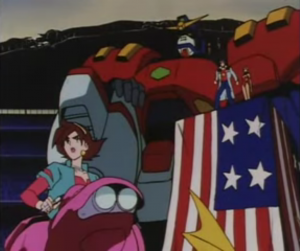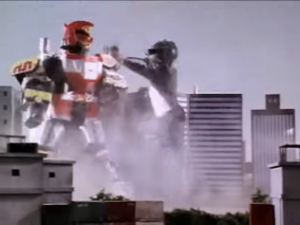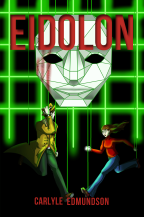4 Excerpts from the Mecha Piloting Guide–Friday Four
- July 1st, 2016
- Posted in Genre Savvy Survival Lists . Lists . Tropes and Writing
- Write comment
 Congratulations on being selected for the Giant Robot Piloting Program! I assume this means you’re a 15-year-old Japanese boy, but I guess you don’t have to be. One thing they might not teach you in the program, though, is that nothing takes as much work to keep running as a giant mech. The humanoid form doesn’t leave a lot of room for complex machinery, and scaling that up to 50 feet tall doesn’t help quite as much as you’d expect. And that’s without considering all the missiles, guns, laser swords, jetpacks and other add-ons these Mecha have to be able to swap out at a moment’s notice. All this is left up to the unsung heroes, the Giant Mecha mechanics (not to be confused with giant Mecha-Mechanics, which are a totally different and much more confusing issue), who have to get these things up and running after every city-destroying slugfest they take part in. So what I’ve got here are a few pro tips to help ease the burden on our intrepid robo-engineers and keep your giant robots in fighting shape.
Congratulations on being selected for the Giant Robot Piloting Program! I assume this means you’re a 15-year-old Japanese boy, but I guess you don’t have to be. One thing they might not teach you in the program, though, is that nothing takes as much work to keep running as a giant mech. The humanoid form doesn’t leave a lot of room for complex machinery, and scaling that up to 50 feet tall doesn’t help quite as much as you’d expect. And that’s without considering all the missiles, guns, laser swords, jetpacks and other add-ons these Mecha have to be able to swap out at a moment’s notice. All this is left up to the unsung heroes, the Giant Mecha mechanics (not to be confused with giant Mecha-Mechanics, which are a totally different and much more confusing issue), who have to get these things up and running after every city-destroying slugfest they take part in. So what I’ve got here are a few pro tips to help ease the burden on our intrepid robo-engineers and keep your giant robots in fighting shape.
4. Avoid the Water
You’d think this would go without saying… but that giant robot? It’s still a robot. It likely runs on some form of electricity, and electronic devices don’t like getting wet–try giving Siri a bath and see for yourself. Now, it’s true that a lot of kaiju and giant monsters do tend to emerge from the ocean, but that’s all the more reason not to engage them there. This is basic tactics 101: take the high ground, and don’t give the enemy a home-field advantage. And aside from the possibility of short circuits and electrical failure, there’s other problems that come from submerging your multi-billion dollar machine in the ocean, like saltwater corrosion or water leaking into your likely-not-waterproof cabin.
Taking your mecha out for a swim isn’t just bad for the robot itself, though. Just think of how many different fluids are in your car: brake fluid, transmission fluid, oil… this thing’s hundreds of times larger and more complex. If your Mecha takes battle damage and starts spewing superconductor cooling fluid or material from its nuclear power core, that’s going to utterly destroy the local environment, and that’s on top of the damage the monster has done. You might end the battle only to realize things would’ve been better off had you just let Godzilla enjoy his yearly vacation to Tokyo (or New York… although I think even he wants to forget that one).
3. Combining Robots are a Dangerous Thing
Your Mecha is a crowning achievement of engineering, no matter its design. But you know what’s more complicated than one 20 story robot? Five 8 story robots that combine to make one 20 story one. While a single giant robot needs most of the same points of articulation as a human (plus a few for shoulder cannons and whatnot), these combining robots have to have dozens more, each one introducing a new point of failure that can be exploited by the enemy. When you’re turning a Lion robot into the arm of a humanoid robot, that requires a lot of changing and transforming… all to create a tenuous connection between arm-bot and torso-bot. Just ask the Power Rangers how many times their MegaZords have taken critical damage, only for the combination to fail and the individual Zords to retreat slowly back into the ground in a manner that’s suspiciously identical to how they emerged.
Now, there is some level of redundancy when you’ve got control systems for five different robots available, but all that really is, in the end, is added expense. It might look cool to watch your robots transform into an even more powerful setup, but you have to realize that takes a LOT more time than you think. And is that city-destroying monster just going to take a break and soak in the awesomeness alongside you? No, he’s going to keep destroying the city–or maybe take your mech out before it’s finished combining. You don’t want that kind of egg on your giant metal face, do you?
2. The Abandoned Warehouse District
No two ways about it–few defenders of the world cause as much collateral damage as Giant Mecha pilots. Every time your robot falls down, launches an attack, or even so much as takes a step, the city around them is destroyed. You think that highway was designed to support a 40,000 ton mecha-foot? Of course it wasn’t. Civil Engineers didn’t plan for that. That’s why the choice of battlefield needs to be a conscious decision by the pilot… but they taught you that, right? It’s why 90% of Gundam battles take place in outer space.
Fortunately, many cities where Giant Robot fights take place have a part of town that few people rarely venture into. It’s never been clear to me quite why, especially with how limited the real estate is, but Japan seems to have a huge amount of space dedicated to empty warehouses. Perhaps it was some kind of legal decree created for exactly this reason. In any case, due to their proximity to the harbor and being conveniently devoid of life, these make for an excellent site to engage giant monsters emerging from the sea. Heck, if you’re lucky, you might be able to take them out before they reach the city center.
Let’s just hope there aren’t any of your schoolmates out there throwing a secret warehouse rave, or you might be scraping them off your super-armored boots…
1. Wait on the Upgrades, Opt-in to Betas
When your army’s pumping out Giant Robots, new models come along way more frequently than you’d expect. A little too fast, actually, as a lot of the time these “upgraded” models are actually worse off than what they were replacing. Sometimes that means the upgraded Mecha doesn’t function the way it’s supposed to; other times it has a fatal flaw that’s easily exploited by the enemy, or even put there deliberately by spies. And guess who’s going to be coming to the rescue when those mass-produced EVAs go on the fritz? That’s right, it’s your older version (just kidding, Asuka!).
But on the other end of the spectrum, there’s prototype units. You’d think the only difference between the prototype and the next-gen upgrade would be working out the kinks, but you’d be wrong. No, when you’re making a Mecha Prototype, you don’t just plan for the production line, you plan for EVERYTHING. What this tends to mean to our young Mecha Pilots out there is that getting your hands on a prototype is going to give you a huge advantage in a fight. Even if your enemy pilots are far more experienced than you, they won’t have a clue what to expect from your one-of-a-kind prototype. Photon cannons? Anti-matter grenades? Who knows! Give that thing a red paint job and you’re practically invincible.
Well, young Mecha Pilot, are you ready to take to the field of battle? Or maybe you have some ideas of your own on how best to handle this oversized armor you’ve been granted control of? You can let me know in the comments, or on Twitter @RetroPhaseShift. If you enjoyed the article, be sure to share it, be that with friends on social media or in places that might appreciate some tongue-in-cheek Mecha discussion.








http://www.nbc.com/saturday-night-live/video/connectatron/2858445